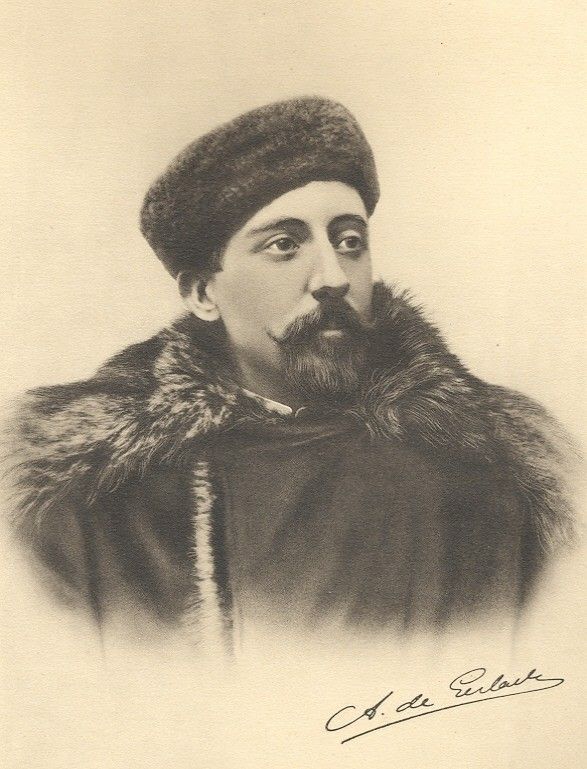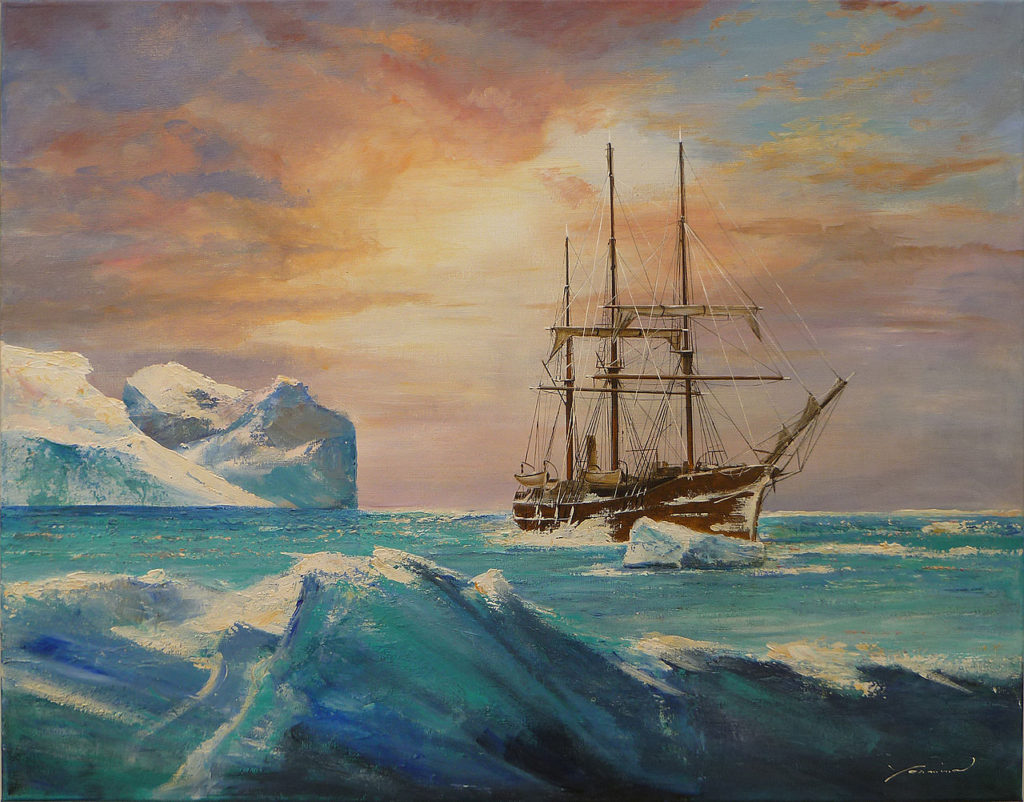
The first humans to overwinter in Antarctica
In 1897–99, Adrien de Gerlache sailed the Belgica into Antarctica’s ice-filled waters. This was the first major scientific expedition of the heroic age and included two legendary polar explorers (Frederick Cook and Roald Amundsen at the start of their Polar careers).
Amundsen would later be the first to reach the South Pole and Cook would become infamous for falsely claiming he reached the North Pole first. However, at the time of the Belgica journey Frederick Cook was perhaps the greatest practitioner of polar medicine and would go on to save the Belgica’s crew.
A young Belgian naval lieutenant, Adrien Victor Joseph, Baron de Gerlache de Gomery (Adrien De Gerlache), supported by the Brussels Geographical Society, initiated and led the first Belgian Antarctic scientific expedition with an international crew.
In his ship, Belgica, de Gerlache departed Antwerp on 16 August 1897. By December they had reached Punta Arenas but because de Gerlache decided to explore Tierra del Fuego, they arrived near the Antarctic Peninsula in late January, dangerously close to the end of summer.
Crossing the Antarctic Circle on 15 February they encountered pack ice, but despite the dangers, de Gerlache pushed the Belgica too far into the ice, where it became trapped. Unfortunately they were totally unprepared for a long-term stay in Antarctica. They carried only four sets of cold-weather clothing and perhaps a year’s worth of food, when the ice could keep them for two years or more.
In the darkness of an unplanned winter, the atmosphere of uncertainty gave way to frustration, panic, anger, and lunacy. Depression was common among the crew and two sailors went insane. One never recovered. Even the ship’s cat turned strange and died.
The crew settled into a routine as outlined by Cook in his book ‘Through the First Antarctic Night’ : “Rise at 7.30 am; coffee at 8; 9 to 10, open air exercise; 10 to 12, scientific work … for the officers, and for the marines, bringing in the snow, melting snow for water, replenishing the ship’s stores, repairing the ship, building new quarters, making new instruments, and doing anything which pertains to the regular work of the expedition; 12 to 2 pm dinner, and rest or recreation, 2 to 4, official work … 6 to 7, supper; 7 to 10, card-playing, music, mending, and on moonlight nights, excursions. At 10 o’clock we went to sleep.”
Despite the regimentation and keeping themselves busy, due to the lack of supplies of fresh food, scurvy broke out amongst the crewmembers and without intervention would have likely killed the entire crew.
Frederick Cook saves the Belgica
Much of this story is taken from the excellent book by Jason C. Anthony (Hoosh : Roast Penguin, Scurvy Day, and Other Stories of Antarctic Cuisine).
Cook and Amundsen knew the importance of fresh meat in preventing scurvy, and had stored seal and penguin carcasses in the ice before all wildlife fled the advancing winter.
Cook realised from his time with the Inuit people that scurvy (caused by a lack of vitamin C) was the result of a dietary deficiency and that cooking food could make it deficient. Cook, with support from the young Roald Amundsen, recommended to De Gerlache that everyone on board eat fresh penguin and seal meat daily (as it contains vitamin C, though this wasn’t known at the time). The commander refused to listen as he had a personal aversion to the taste (probably due to it being badly prepared by the cook) and forbade his crew from eating it. However, once de Gerlache and Lecointe (the captain) took to their beds with scurvy, the two Arctic veterans effectively took over.
In spite of De Gerlache’s opposition Cook was by late winter able to prescribe the meat as medicine rather than food. Those who obeyed first showed an immediate response: “I am not dead!” wrote Captain Georges Lecointe. “The coma into which I plunged yesterday did not even last very long. I came out of it, mechanically ate a piece of penguin meat and, a few hours later, I woke up feeling much stronger.” Taking no chances, Lecointe ate penguin every day until they left Antarctic waters.
Initially, Roald Amundsen had been ill with scurvy, but as he recovered under Cook’s guidance, the Norwegian helped bring the Belgica’s crew back to life with the fresh meat he hunted: “Six seals with a layer of fat three inches thick appeared near the ship yesterday morning. Their fate requires no further explanation.”
Amundsen seems to be the only one who actually liked the flavours of Antarctica. “Penguin meat tastes excellent,” he wrote, “but you must ensure that all the fat is cut off the meat. It does not need to be treated with vinegar to make it taste good; you simply take the meat as it is and fry it in a pan with a knob of butter.” Some of it he ate raw. One emperor penguin, which can weigh up to ninety pounds, was enough to feed twenty-five men, but Amundsen preferred the tender meat of the fourteen-pound Adélie.
Thanks in part to Cook’s instruction, Amundsen’s future expeditions to both Poles never suffered from scurvy, a claim very few early explorers could make.
By the end of July the crew was living mainly on penguin meat, with a marked improvement in their health. De Gerlache was the last to consent, and thus the last to be cured, but subsequently offered rewards to the crew for bringing in penguins for the larder —one frank for living birds, fifty centimes for dead ones. This was easy money, as it turned out. The crew learned in their final months that they could summon both penguins and seals to the ship by simply playing a tune on their cornet.
Eventually the crew of the Belgica decided to escape from the ice by dynamiting a trench to open water, which they did, but overnight the trench closed up and depression set in. Luckily the trench re-opened and they managed to reach and area of open water. They were still hemmed in by ice and were 11 kilometers (7 miles) from freedom with another winter approaching. Weeks passed as they floated in the small section of open water and then the ice opened in a path directly to where they were sitting so they made their way to freedom on March 14, 1899 and then happily returned to Norway, arriving in November 1899.
In an ironic event that might have spelled the death of the expedition, Frederick Cook spent a frosty midwinter night alone, away from the ship, to observe the stars from his sleeping bag. His hair froze to the hood of his bag, but he avoided a worse fate. On returning to the ship at dawn, he “learned that Lecointe, not knowing of my presence on the ice, had taken me for a seal, and was only waiting for better light to try his luck with the rifle.”
The Belgica was the first time that a group of humans had over-wintered in Antarctic waters and they gained much scientific knowledge in the process. As we know Amundsen went on to achieve fame as the first person to reach the South Pole, and Cook, though the saviour of the expedition, would later falsely claim he was the first to climb Mt. McKinley, the highest mountain in North America, and the first to reach the North Pole. In later life he was imprisoned for mail fraud from 1923 till 1929 then released but received a presidential pardon in 1940 and died that year.
Below is a painting of the Belgica (2012) by the Belgian painter Yasmina


